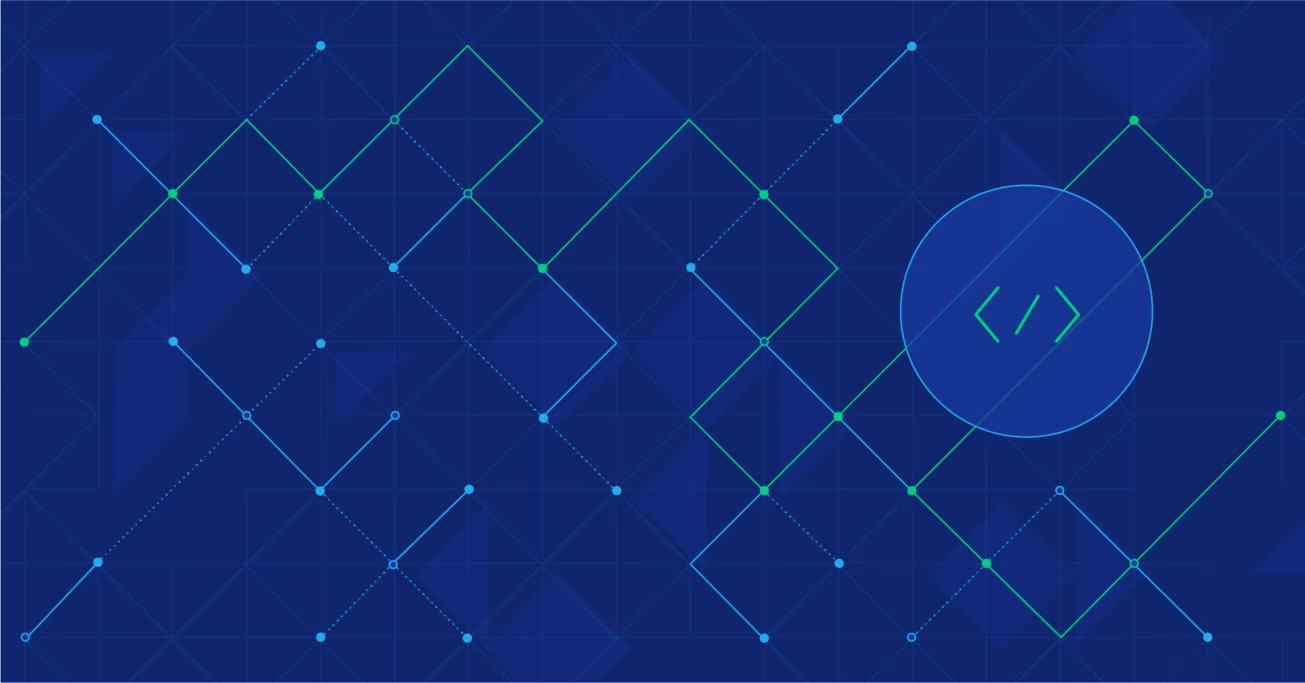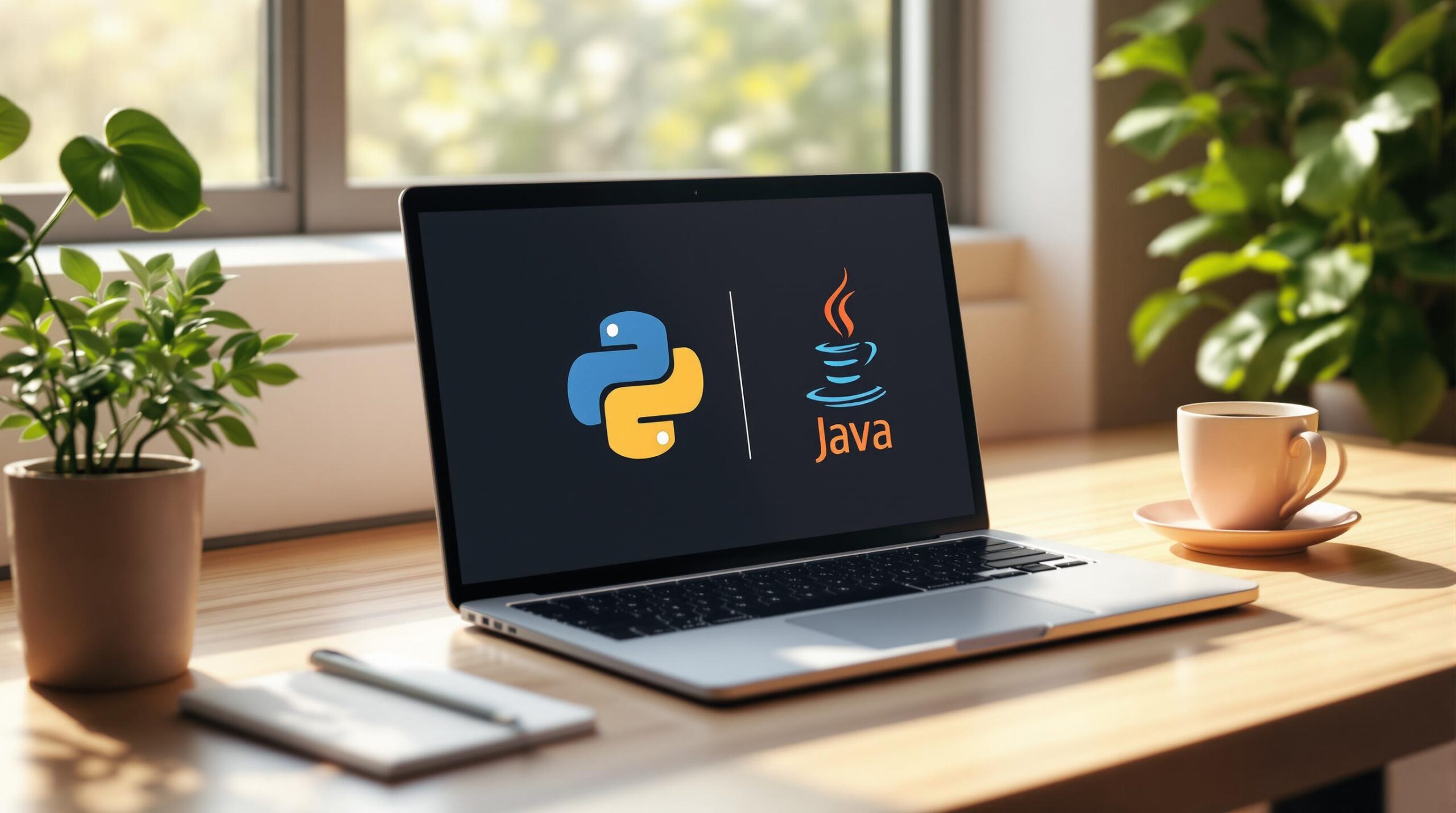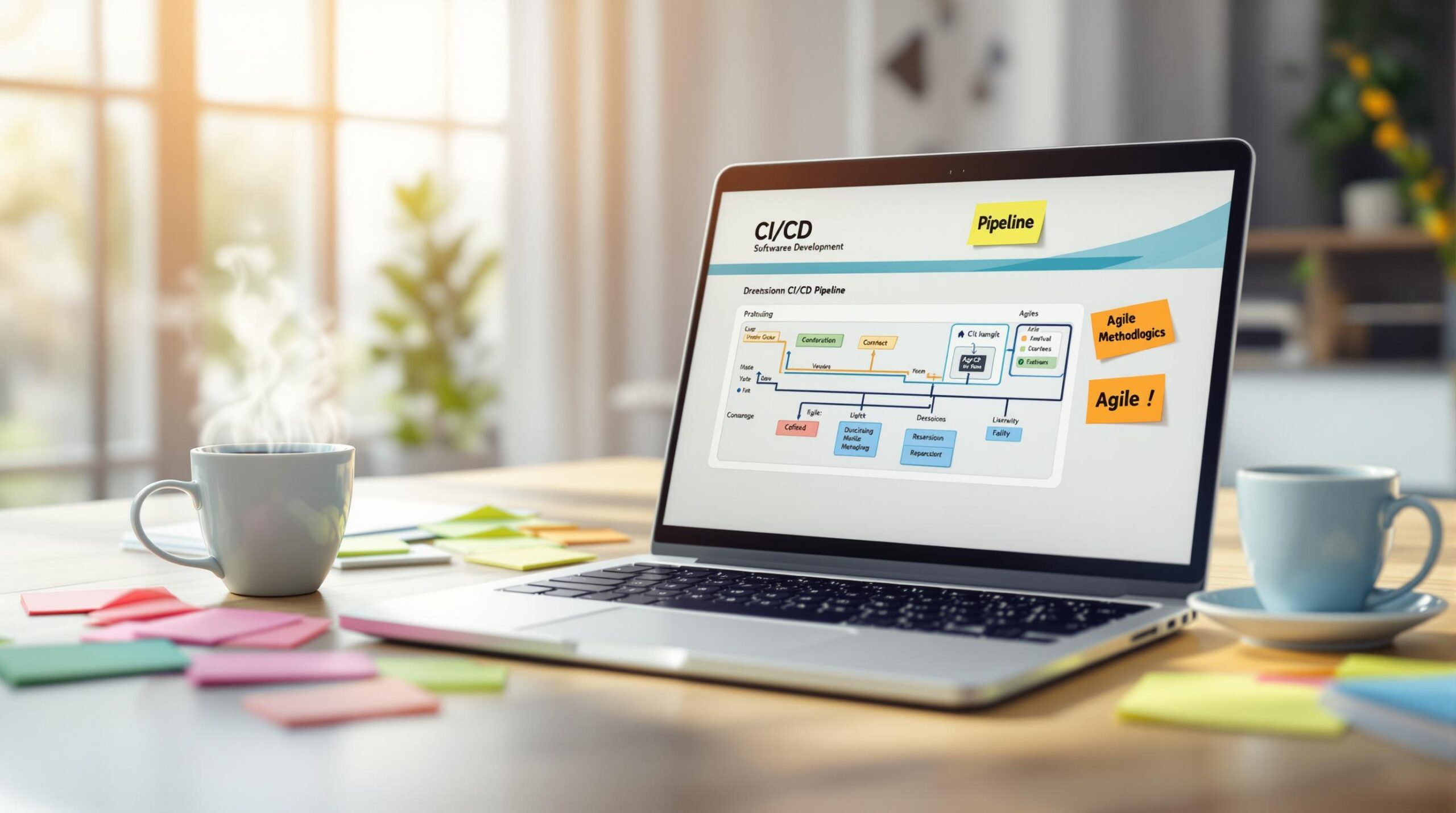Choosing between Python and Java in 2025 depends on your career goals and the type of projects you want to work on:
- Choose Python if you’re interested in data science, AI, machine learning, or web development. It’s beginner-friendly, with simple syntax and strong demand in emerging fields.
- Choose Java if you’re aiming for enterprise software, Android app development, or cloud-based systems. It’s structured, reliable, and a staple in large-scale applications.
Quick Comparison Table:
| Feature/Use Case | Python | Java |
|---|---|---|
| Ease of Learning | Beginner-friendly, simple syntax | More complex, structured syntax |
| Primary Use Cases | Data science, AI, web development | Enterprise software, Android apps |
| Typing System | Dynamic (flexible, runtime errors) | Static (predictable, compile-time errors) |
| Performance | Slower due to runtime flexibility | Faster with early error detection |
| Career Paths | Data Scientist, AI Engineer, Web Dev | Enterprise Dev, Android Dev, Cloud Eng |
| Average Salary | $120,000–$150,000 (AI roles) | $110,000–$130,000 (enterprise roles) |
Both languages are excellent choices, but your decision should align with your career aspirations and the industries you want to work in. Let’s dive deeper into their differences.
Key Differences Between Python and Java

Knowing the main differences between Python and Java can help you decide which language to learn first. Let’s break down how they differ in syntax, typing systems, and programming styles.
Syntax and Readability
Python and Java approach code structure in distinct ways. Here’s a quick comparison of how a basic class is defined in each language:
# Python
class Car:
def __init__(self, color, model, year):
self.color = color
self.model = model
self.year = year
// Java
public class Car {
private String color;
private String model;
private int year;
public Car(String color, String model, int year) {
this.color = color;
this.model = model;
this.year = year;
}
}
Python uses indentation for structure, making it simpler and easier to read, especially for beginners. Java, on the other hand, relies on curly brackets and semicolons, resulting in a more detailed and formal syntax.
Static vs. Dynamic Typing
The way these languages handle data types is another key difference. Here’s how they stack up:
| Feature | Java (Static Typing) | Python (Dynamic Typing) |
|---|---|---|
| Type Handling | Types are defined at compile time, catching errors early | Types are determined at runtime, offering more flexibility |
| Error Detection | Errors are caught before execution | Errors are caught during execution |
| Code Flexibility | Less adaptable but more predictable | Highly adaptable but less predictable |
| Performance | Faster due to early error detection | May have runtime performance overhead |
"Static typing, as noted by Orient Software, emphasizes stability and early error detection, making Java a risk-averse choice" [2].
Object-Oriented Programming
Both Python and Java support object-oriented programming (OOP), but they differ in how they implement it:
- Java’s Approach: Java enforces strict OOP rules. All code must reside within classes, and access control is explicitly defined. This approach builds strong programming discipline.
- Python’s Approach: Python offers more flexibility. It supports multiple inheritance and allows both procedural and OOP styles, giving developers more options but less rigid structure.
These differences affect how developers solve problems. Python’s adaptability makes it great for beginners, while Java’s stricter rules help build a solid foundation in programming.
Learning Curve and Resources
Understanding the learning curve and the resources available for Python and Java can help you decide which language fits your career goals best.
Ease of Learning for Beginners
Python’s clean and straightforward syntax makes it a go-to option for beginners. It allows learners to focus on programming concepts rather than getting bogged down by complex rules. According to recent surveys, 58% of beginners picked Python as their first language, compared to 39% who chose Java [3].
Here’s a quick side-by-side look at some key learning aspects:
| Feature | Python | Java |
|---|---|---|
| Syntax Simplicity | Intuitive, minimal syntax | More verbose, explicit declarations required |
| Development Setup | Easy, minimal setup needed | Requires JDK installation and setup |
While syntax is important, the availability of learning resources and community support can significantly influence how quickly you master a language.
Community and Learning Resources
Both Python and Java have strong ecosystems, but they cater to different types of learners. For example, the University of Michigan’s "Python for Everybody" specialization has drawn over 1.7 million learners, showing Python’s widespread appeal [2].
Top resources for learning Python:
- Python.org: Offers detailed documentation and tutorials.
- Python Crash Course by Eric Matthes: A popular beginner-friendly book.
Top resources for learning Java:
- The Java Tutorials by Oracle: Comprehensive official documentation.
- Effective Java by Joshua Bloch: Focused on advanced concepts for intermediate learners.
"Python’s user-friendliness and abundant resources make it a top choice for beginners" [3].
Python also benefits from an active community, which means beginner questions are quickly answered on platforms like Stack Overflow and GitHub. Notably, Python is the second most-used programming language on GitHub [2].
For structured training, platforms like KodNest provide courses in both Python and Java, including AI-driven mentorship and hands-on projects, priced at ₹26,999.
Industry Demand and Career Opportunities in 2025
Knowing where the industry is headed can help you choose the right programming language to match your career goals.
Job Market Trends
Python continues to thrive, especially in data science and AI. Reports show it remains the second most popular programming language [4].
| Domain | 2025 Trends |
|---|---|
| AI & Machine Learning | Python leads, especially in autonomous systems |
| Enterprise Solutions | Java is key in cloud-native enterprise projects |
| IoT & Edge Computing | Java excels in embedded systems; Python shines in data handling |
| FinTech | Both languages grow in blockchain and digital banking applications |
These trends shape the roles available for Python and Java developers.
Career Path Examples
Python and Java developers often follow distinct paths:
Python Career Paths:
- Data Scientists and ML Engineers (Average salary: $118,000)
- AI Specialists and Research Scientists
- Backend Web Developers (Django/Flask)
Java Career Paths:
- Enterprise Software Developers (Average salary: $105,000)
- Android Development Specialists
- Cloud Architecture Engineers
Compensation also plays a big role when deciding between these languages.
Salary Comparisons
By 2025, salaries will vary depending on specialization and location. For instance, Python developers working in data science roles in San Francisco average $130,000, while Java developers in enterprise software roles earn around $125,000. Major tech hubs consistently offer top salaries for both languages [1].
"The growth of AI and machine learning has significantly increased the demand for Python skills, while Java maintains its stronghold in enterprise software development" [1].
To stand out in 2025, Python developers should focus on machine learning frameworks and cloud platforms. Meanwhile, Java developers should hone their skills in cloud-native tools and concurrency techniques.
Your choice between Python and Java largely depends on the industry you aim to work in. Python is ideal for data-focused roles, while Java is a go-to for enterprise-level development. Both offer excellent career opportunities and competitive pay in 2025.
sbb-itb-f454395
Applications of Python and Java
Python and Java each shine in different areas, making them suited for specific projects and career paths. Let’s break down where these languages excel to help you decide which one aligns with your goals.
Web Development
Both Python and Java play pivotal roles in web development, but they do so using different frameworks. Python’s Django is ideal for building content-heavy platforms, while Flask is perfect for lightweight apps and APIs. On the other hand, Java’s Spring framework is a go-to choice for enterprise-level systems that demand scalability and reliability.
| Framework | Best For | Notable Users |
|---|---|---|
| Django (Python) | Content-heavy sites, fast setup | Instagram, Mozilla |
| Flask (Python) | Lightweight apps, APIs | Pinterest, Reddit |
| Spring (Java) | Enterprise systems, microservices | Netflix, LinkedIn |
Beyond just web development, Python and Java thrive in other specialized fields like data science and enterprise solutions.
Data Science and Machine Learning vs. Enterprise Software
Python dominates the worlds of data science and machine learning, thanks to libraries like TensorFlow and PyTorch. For instance, NASA uses Python for analyzing satellite data and running machine learning models.
"The growth of AI and machine learning has significantly increased the demand for Python skills, while Java maintains its stronghold in enterprise software development" [1].
Java, meanwhile, is a powerhouse for enterprise software. Companies like IBM rely on Java for processing large-scale, mission-critical data, while Oracle uses it for systems requiring robust business logic and top-notch security.
While these fields highlight each language’s strengths, their roles in mobile app development bring even more differences to light.
Mobile App Development
Java is a staple for Android development, powering many popular apps, including Instagram’s Android version. This makes it a must-know for mobile developers focused on Android. Python, however, has a smaller role in mobile app development, mainly through frameworks like Kivy, which has been used in parts of Dropbox’s functionality.
When choosing between the two, it often comes down to your career focus:
- Pick Python if you’re interested in data science, AI/ML, or fast web development.
- Pick Java if you’re aiming for enterprise software, Android apps, or large-scale systems.
Your decision should reflect your goals – Python is user-friendly and great for data-driven projects, while Java offers the reliability needed for enterprise and mobile solutions.
Future Trends for Python and Java
By 2025, Python and Java are evolving to tackle the growing needs of AI, cloud computing, and IoT. Knowing these trends can help you decide which language to focus on first.
Predicted Trends and Language Evolution
Python is solidifying its role in artificial intelligence and machine learning while expanding its capabilities in cloud computing. Its compatibility with platforms like AWS Lambda and Google Cloud Functions makes deploying cloud-based applications easier.
| Technology Area | Python’s Focus | Java’s Focus |
|---|---|---|
| Cloud Computing | Integration with AWS Lambda, Google Cloud Functions | Spring Cloud and microservices architecture |
| AI/ML | Improved TensorFlow and PyTorch tools | GraalVM for better performance |
| IoT Development | Libraries like PySerial, RPi.GPIO for hardware interaction | Project Loom for enhanced concurrency |
Java is evolving with tools like Project Loom to handle concurrency more efficiently and GraalVM to boost performance across multiple programming languages.
"The AI job market is set to grow 37% between now and 2030." – Grandview Research [1]
These advancements show how both languages are adapting to modern challenges, but how do they measure up in the long run?
Long-Term Viability
Both Python and Java have staying power, excelling in different areas. Major companies like Google, Netflix, and Amazon depend on Python for data-focused applications, while LinkedIn and Oracle use Java for large-scale enterprise systems.
Python shines in AI, machine learning, and data science, while Java remains a favorite for enterprise and mobile development. Python’s straightforward syntax makes it a go-to for emerging tech, whereas Java’s reliability continues to drive enterprise solutions. Both languages are well-positioned for the future, offering unique strengths depending on your goals.
Conclusion: Choosing the Right Language for Your Goals
Comparing Python and Java
Python and Java shine in different areas, making each a strong choice depending on your career path. Their differences influence how they’re used in the tech world today.
| Career Focus | Python Strengths | Java Strengths |
|---|---|---|
| Entry Level | Easier to learn with simpler syntax | Builds strong programming fundamentals |
| Salary Range | Average $120,000, up to $150,000 for AI roles | Ranges from $110,000 to $130,000 |
| Key Industries | Data Science, AI/ML, Web Development | Enterprise Software, Android, Big Data |
| Job Growth (2022-2032) | High demand in Data Science and ML | Steady growth in Cloud and Enterprise |
Language Choices Based on Career Goals
Pick the language that matches your career aspirations and the industry you’re aiming for.
If you’re drawn to data science and AI, Python is a clear winner. Machine learning engineers skilled in Python can earn impressive salaries, averaging around $160,586 annually [1].
For those targeting enterprise software development, Java is a strong contender. Cloud engineers with Java expertise earn approximately $130,000 per year, with demand expected to grow steadily through 2032 [2].
Your decision between Python and Java should reflect your career goals and the types of projects you want to tackle.
Practical Advice for Developers
Platforms like KodNest offer in-depth courses for both Python and Java. Their Full Stack Development program provides hands-on experience, helping you apply what you learn to real-world scenarios.
The key to success in programming lies in mastering the basics and using them to solve practical challenges. Whether you choose Python or Java, focus on building your skills and working on meaningful projects. Both languages open doors to rewarding careers with strong growth potential, making them excellent options for developers in 2025.
FAQs
Which is better for future, Java or Python?
Choosing between Java and Python depends on what you want to achieve in your career. Python shines in areas like data science, AI, and backend development, while Java is a top choice for enterprise software, Android apps, and cloud-based projects.
Why Choose Python?
- Strong presence in data science and AI/ML
- Increasing use in backend web development
- Simple syntax, making it beginner-friendly
- Advanced tools for AI and machine learning
Why Choose Java?
- A cornerstone for enterprise-level software
- Essential for Android app development
- Widely used in cloud computing and big data
- Performance improvements with GraalVM
"According to industry trends [1], Python shows particularly strong growth in data science and AI sectors, while Java maintains its stronghold in enterprise applications and Android development."
If you’re interested in AI or machine learning, Python is the go-to language. For enterprise systems or Android apps, Java is the better option. Both languages are evolving to meet modern demands, so pick the one that aligns with your career goals.
Is Java or Python harder to learn?
Python is often seen as easier to learn than Java [2]. Here’s a side-by-side look:
| Learning Aspect | Python | Java |
|---|---|---|
| Setup & Syntax | Simple, beginner-friendly | More complex, structured |
| Core Concepts | Gradual intro to programming | Emphasizes OOP from the start |
| Error Handling | Flexible with dynamic typing | Strict static typing |
For beginners, Python offers a smoother start and quicker results. On the other hand, Java’s structured approach helps build a solid understanding of programming concepts, which can be valuable for long-term growth [2].
If you’re looking for fast prototyping, Python is the way to go. But if you want a strong foundation for complex development, Java might be the better choice. Think about your learning style and career goals when deciding.





